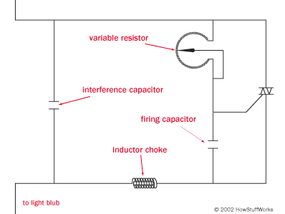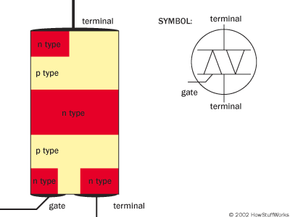The Triac
In the last section, we saw that a dimmer switch rapidly turns a light circuit on and off to reduce the energy flowing to a light switch. The central element in this switching circuit is a triode alternating current switch, or triac.
A triac is a small semiconductor device, similar to a diode or transistor. Like a transistor, a triac is made up of different layers of semiconductor material. This includes N-type material, which has many free electrons, and P-type material, which has many "holes" where free electrons can go. For an explanation of these materials, check out How Semiconductors Work. And, for a demonstration of how these materials work in a simple transistor, see How Amplifiers Work.
Advertisement
Here's how the N-type and P-type material is arranged in a triac.

You can see that the triac has two terminals, which are wired into two ends of the circuit. There is always a voltage difference between the two terminals, but it changes with the fluctuation of the alternating current. That is, when current moves one way, the top terminal is positively charged while the bottom terminal is negatively charged, and when the current moves the other way the top terminal is negatively charged while the bottom terminal is positively charged.
The gate is also wired into the circuit, by way of a variable resistor. This variable resistor works the same basic way as the variable resistor in the old dimmer switch design, but it doesn't waste nearly as much energy generating heat. You can see how the variable resistor fits into the circuit in the diagram below.
So what's going here? In a nutshell:
- The triac acts as a voltage-driven switch.
- The voltage on the gate controls the switching action.
- The variable resistor controls the voltage on the gate.
In the next section, we'll look at this process in greater detail.
